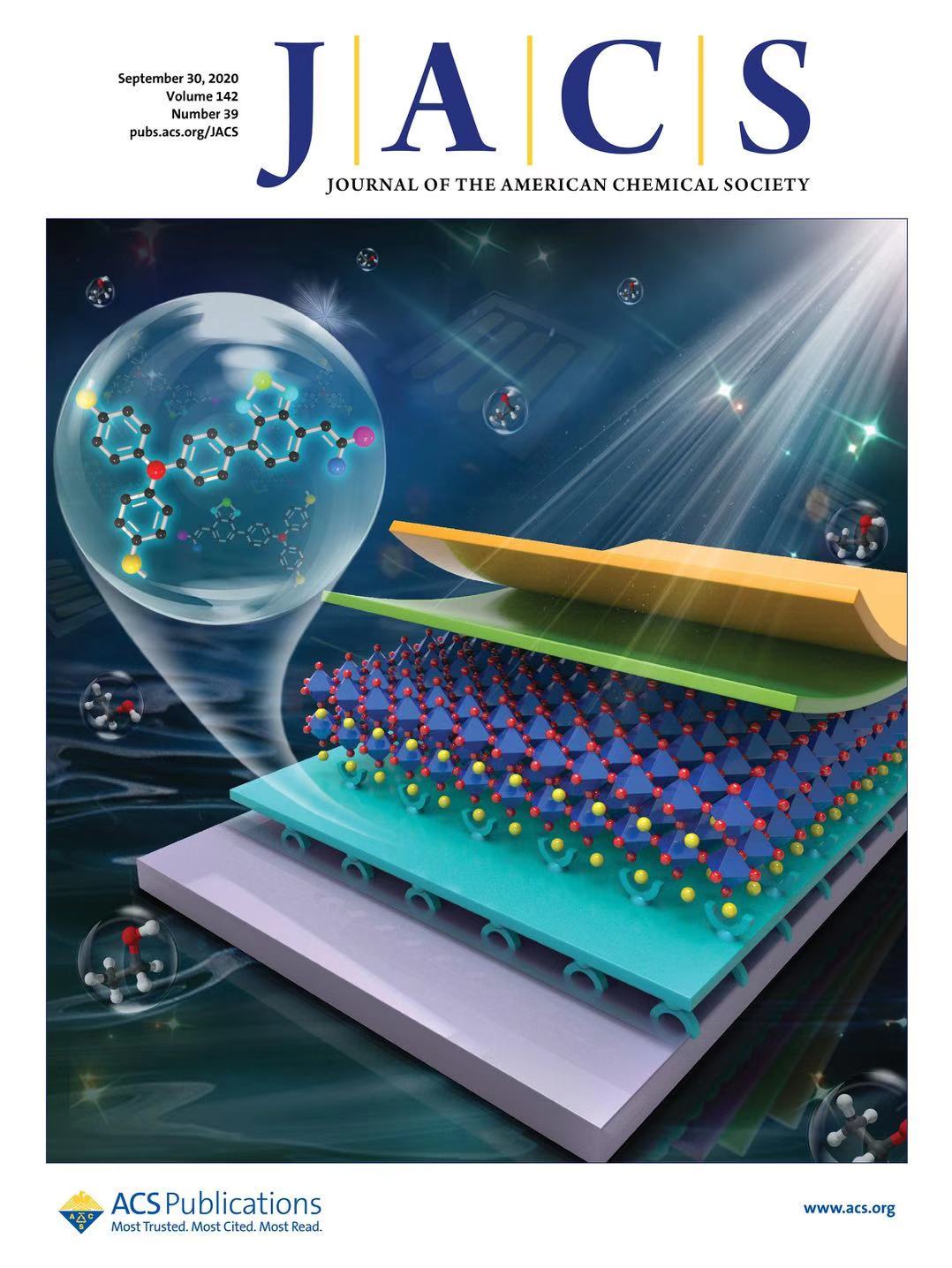The development of organic and perovskite solar cells has seen significant advances in materials innovation, power conversion efficiencies (PCEs), and device stability. With that in mind, the researchers in the Department of Materials Science and Engineering (MSE) at Southern University of Science and Technology (SUSTech) have made continuous efforts for significant progress in this field.
MSE Professor Xugang Guo has led his research team to publish several important papers in high-level journals over the last few months, including Advanced Materials (IF = 27.398), SCIENCE CHINA Chemistry (IF = 6.356), Energy & Environmental Science (IF = 30.289), Advanced Functional Materials(IF = 16.836), and Journal of the American Chemical Society (IF = 14.612).
In a recent paper titled “A Narrow-Bandgap n-Type Polymer with an Acceptor-Acceptor Backbone Enabling Efficient All-Polymer Solar Cells,”published in Advanced Materials , the research group led by Professor Xugang Guo developed a new narrow-bandgap polymer acceptor L14 (Figure 1), featuring an acceptor–acceptor (A–A) type backbone, which is synthesized by copolymerizing a dibrominated fused-ring electron acceptor (FREA) with distannylated bithiophene imide. L14 shows not only a narrow bandgap and high absorption coefficient but also low-lying frontier molecular orbital (FMO) levels. Such FMO levels yield improved electron transfer characteristics, and unexpectedly, without sacrificing open-circuit voltage (Voc), which is attributed to a small non-radiative recombination loss of 0.22 eV. Benefiting from the improved photocurrent along with the high fill factor and Voc, an excellent efficiency of 14.3% is achieved, which is among the highest values for all-polymer solar cells (all-PSCs). The results demonstrate the superiority of narrow-bandgap A–A type polymers for improving all-PSC performance and pave a way toward developing high-performance polymer acceptors for all-PSCs.

Figure 1. (a) The J–V characteristics of the all-PSCs based on L14 with an acceptor-acceptor (A-A) backbone and its donor-acceptor (D-A) analogous polymer L11. (b) Plots of PCE against Voc for all-PSCs reported previously with PCEs over 8% and this work. (Adv. Mater. 2020, 32, 2004183)
Recent advances in the development of polymerized FREA have promoted the PCE of all-PSCs over 13%. However, the monomer of an FREA typically consists of a mixture of three isomers due to the regioisomeric brominated end groups. In this work, the two isomeric end groups are successfully separated to resolve the regioisomeric issue. Three polymer acceptors, namely PY-IT, PY-OT, and PY-IOT (Figure 2), are developed, where PY-IOT is a random terpolymer with the same ratio of the two acceptors. Interestingly, from PY-OT, PY-IOT to PY-IT, the absorption edge gradually redshifts which should be beneficial for photocurrent improvement in solar cells. Theoretical calculation indicates that the lowest unoccupied molecular orbitals (LUMOs) are distributed on the entire molecular backbone of PY-IT, contributing to the enhanced electron transport.
Consequently, the PM6: PY-IT system achieves an excellent PCE of 15.05%, which is significantly higher than those for PY-OT (10.04%) and PY-IOT (12.12%) and also the highest value in All-PSCs. This work demonstrates that the site of polymerization on FREAs strongly affects device performance, offering insights into the development of efficient polymer acceptors for all-PSCs. This work is recently published in Advanced Materials, titled “Precisely Controlling the Position of Bromine on the End Group Enables Well-Regular Polymer Acceptors for All-Polymer Solar Cells with Efficiencies over 15%”.

Figure 2. Three polymer acceptors (PY-IT, PY-OT, and PY-IOT) without regioisomeric issues are developed. The all-PSCs based on PM6: PY-IT achieve an excellent PCE of 15.05%, significantly higher than those based on PY-OT (10.04%) and PY-IOT (12.12%). (Adv. Mater. 2020, 32, 2005942)
The Voc of all-PSCs is typically lower than 0.9 V even for the most efficient ones. Large energy loss is the main reason for limiting Voc and efficiency of all-PSCs. In their third paper published in SCIENCE CHINA Chemistry and entitled “Reducing energy loss via tuning energy levels of polymer acceptors for efficient all-polymer solar cells.”, the team used electron-deficient building blocks based on bithiophene imides along with materials design to effectively tune the lowest LUMO energy levels of polymer acceptors (Figure 3), which resulted in a reduced energy loss induced by charge generation and recombination loss due to the suppressed charge-transfer (CT) state absorption. Despite a negligible driving force, all-PSC based on the polymer donor and acceptor combination with well-aligned energy levels exhibited efficient charge transfer and achieved an external quantum efficiency over 70% while maintaining a large Voc of 1.02 V, leading to a 9.21% efficiency. Through various spectroscopy approaches, this work sheds light on the mechanism of energy loss in all-PSCs, which provides a new avenue to achieve efficient all-PSCs with large Voc and drives further development of all-PSCs.

Figure 3. Molecule structures and basic properties of new polymer acceptors based on BTIn and the classical polymer acceptor N2200. (Sci. China Chem. 2020, DOI: 10.1007/s11426-020-9826-4)
The ternary strategy has many advantages in improving the performance of organic solar cells, which has aroused great interest in researchers. It is worth noting that adding the third component to the main binary system will result in a more complex mixed morphology of the active layer. Poor material compatibility can lead to serious molecular disorder and large-scale phase separation, thereby reducing the performance of solar cells. Compared with two small molecules, the compatibility of the two polymers is usually poor. This is the main reason for the lower success rate of the ternary battery based on two polymer donors compared to the ternary battery based on two small molecule receptors. In their fourth paper entitled “Two compatible polymer donors contribute synergistically for ternary organic solar cells with 17.53% efficiency”and published inEnergy & Environmental Science, the team introduced a highly efficient polymer donor material S3 and added it to the classic PM6: Y6 binary system to prepare a ternary organic solar cell. S3 and PM6 have complementary absorption spectra and good compatibility, which is highly favorable for the optimization of the photon capture and morphology of the ternary blend film, thereby simultaneously increasing the short-circuit current density (JSC) and fill factor (FF). At the same time, the highest occupied molecular orbital (HOMO) energy level of S3 is slightly lower than that of PM6, which makes the non-radiative energy loss of ternary organic solar cells lower than that of binary solar cells based on PM6, thereby achieving higher open-circuit voltage. The energy conversion efficiency of the optimized ternary cell is as high as 17.53% (Figure 4), which is one of the highest values reported in ternary organic solar cells. This study further proves that the ternary strategy is a universal method to improve the performance of organic solar cells and provides an effective way to realize high-efficiency and low-cost organic solar cells.

Figure 4. The J–V characteristics of organic solar cells based on PM6: Y6, S3: Y6, PM6:S3: Y6 blend film. (Energy Environ. Sci.2020, DOI:10.1039/D0EE02516J)
Developing organic solar cells based on ternary active layer is one of effective strategies to improve their photovoltaic performance. However, this strategy is very limited success in all-polymer solar cells due to the scarcity of high-performance narrow bandgap polymer acceptor and the challenge of morphology optimization in ternary bulk-heterojunction all-polymer blend films. In Advanced Materials, Professor Xugang Guo group has previously reported polymer acceptor DCNBT-TPC with the ultra-narrow bandgap (ultra-NBG) up to 1.38 eV. This polymer has strong absorption in long wavelength region, which breaks the absorption bottleneck limiting the performance of all-PSCs. In their fifth paper in Advanced Functional Materials and titled “Highly Efficient Ternary All-Polymer Solar Cells with Enhanced Stability.”, the team reported here a ternary system based on an ultra-NBG polymer acceptor DCNBT-TPC, a medium bandgap polymer donor PTB7-Th, and a wide bandgap polymer donor PBDB-T. The optimized ternary all-PSCs yield an excellent PCE of 12.1% with a remarkable short-circuit current density of 21.9 mA cm−2, which is the champion efficiency in ternary all-polymer solar cells (Figure 5). This work demonstrates that the utilization of a ternary all-polymer system based on ultra-NBG polymer acceptor blended with compatible polymer donors is an effective strategy to advance the all-polymer solar cells.

Figure 5. The active layer component, thin film absorption, and J–V characteristics of all-polymer solar cells. (Adv. Funct. Mater. 2020, 2008494)
The charge transporting layers in perovskite solar cells (PSCs) have attracted more and more attention in recent years, which plays a critical role in determining their PCEs and device stability. Specially, the hole-transporting materials (HTMs) have received a great deal of interest. As a way to expedite the commercialization process, three paramount concerns must be addressed when developing new HTMs: i) high performance (superior PCE and device stability); ii) low cost; iii) eco-friendly processability. However, there has been few reports on HTMs simultaneously with low-cost preparation, environmentally friendly processability, and high performance. Recently, Professor Xugang Guo group has designed and synthesized a novel HTM (MPA-BT-CA) involving 2-cyanoacrylic acid (CA) group and donor-acceptor molecular backbone, which shows low-cost production and good alcohol solubility. Encouragingly, a remarkably high PCE of 21.24%, along with good device stability, was achieved in inverted PSCs based on MPA-BT-CA. More importantly, a PCE as high as 20.5% can still be maintained when using ethanol as a processing solvent (Figure 6). The corresponding research results were published in the Journal of the American Chemical Society, titled “Teaching an Old Anchoring Group New Tricks: Enabling Low-Cost, Eco-Friendly Hole-Transporting Materials for Efficient and Stable Perovskite Solar Cells,” and selected as “Spotlights on Recent JACS Publications.”

Figure 6. Chemical structures of the recently developed low-cost HTMs, green-solvent processable HTMs, and HTMs enabling state-of-the-art performance (first row) and chemical structures reported in this work along with a schematic diagram of the multifunctionality of MPA-BT-CA (second row). (J. Am. Chem. Soc. 2020, 142, 16632)

Figure 7. The above work was featured on the cover of Journal of the American Chemical Society.
The above work was supported by the team of Professor Chuluo Yang of Shenzhen University, the team of Professor He Yan of the Hong Kong University of Science and Technology, the team of Professor Feng Gao of Linköping University in Sweden, the team of Professor Hongzheng Chen of Zhejiang University, the team of Professor Fujun Zhang of Beijing Jiaotong University, the team of Professor Long Ye of Tianjin University, and Dr. Zhipeng Kan, researcher of the Chinese Academy of Sciences, Associate Professor Anqiao Shi from Beijing Institute of Technology, Professor Antonio Facchetti and Tobin J. Marks from Northwestern University in the United States, and SUSTech Core Research Facilities (SCRF).
Paper link:
https://onlinelibrary.wiley.com/doi/full/10.1002/adma.202004183
https://onlinelibrary.wiley.com/doi/10.1002/adma.202005942
https://link.springer.com/article/10.1007/s11426-020-9826-4
https://pubs.rsc.org/en/content/articlelanding/2020/ee/d0ee02516j#!divAbstract
https://onlinelibrary.wiley.com/doi/full/10.1002/adfm.202008494






